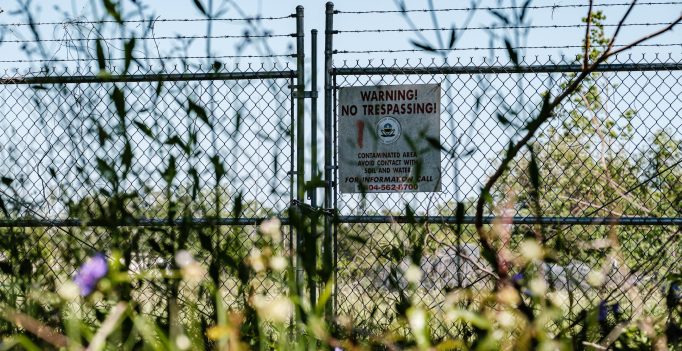The Environmental Protection Agency may have wasted or risked millions of dollars by failing to prevent the spread of contamination hazardous to human health at a Superfund site in Pensacola, Florida, an agency watchdog report found.
An EPA Inspector General’s report released last week said the agency failed to plug existing wells near the Superfund site that could be used by private property owners in the neighborhood to pump contaminated groundwater, and did not prevent those property owners from digging new wells and carrying out soil-disturbing activities, such as home renovations and landscaping.
The 18-acre site at issue, American Creosote Works, three blocks north of Pensacola Bay, is a former wood treatment plant that operated from 1902 to 1981, using creosote and pentachlorophenol (PCP) to treat railroad ties and telephone poles. In 2021, Inside Climate News wrote about the risks associated with the site, which is one of only a handful of Superfund sites nationwide that the EPA considers both an uncontrolled threat to human health and at risk of climate change-related events like flooding and hurricanes.
In September 2020—days before Hurricane Sally dumped 30 inches of rain on Pensacola in four hours and left an oil slick-like sheen on the streets of the adjacent Sanders Beach neighborhood—the EPA found dioxin, the same compound found in Agent Orange, at levels in the soil of nearby homes that were well above Florida’s safety standard for the toxin: One sample came back 35 times higher.
Earlier in 2020, the EPA found naphthalene, which has been linked with neurological and liver disease, in one groundwater sample at more than 785 times the level of Florida’s groundwater cleanup standard.
In 1983, American Creosote Works was placed on the EPA’s Superfund list, denoting it as one of the nation’s most contaminated areas.
During its March 2023 to January 2024 investigation, the inspector general’s office identified 13 properties near the Superfund site with wells or well infrastructure that the EPA has said need remediation.
The wells and infrastructure are problematic because they could be used to pump and spread contaminated groundwater into areas where clean-up activities have taken place and increase the public’s risk of exposure to known carcinogens.
The groundwater around the site contains multiple toxins, including naphthalene, benzene and dioxin.
The U.S. government has so far expended more than $30 million on cleanup efforts at the American Creosote Works site, including the excavation and relocation of some contaminated soils and the pumping and treating of some groundwater. The plant’s former owner declared bankruptcy in 1982, discharging its obligations to pay for the clean up.
As far back as 1994, public records contain at least one instance where residents raised concerns about the use of wells that could spread contamination.
Yet, for more than a decade, from 2002 to 2013, the EPA did not evaluate the affected area for the existence of wells. When the agency did perform such evaluations, officials often relied on visual assessments without physically accessing properties. In some cases, EPA surveyors merely relied on the word of neighbors. This led to errors, the report said, with at least seven properties having well infrastructure that surveyors said had none.
The report also faulted the EPA for failing to negotiate deed and land-use restrictions with property owners to prevent soil-disturbing activities from taking place.
When it came to meeting legal requirements requiring the agency to keep the public abreast of information about the site, the EPA also fell short by providing the public with information that was “inaccurate,” “difficult to find and understand” and “vague.”
By law, the EPA is required to maintain complete and accurate records of each Superfund site’s history, but both the American Creosote Works Superfund site’s website and the physical records were incomplete.
Among other deficiencies, the EPA’s geographic information system inaccurately represents the area of contamination by excluding contaminated parcels that the report said could mislead home owners, real estate agents, contractors and state and local agencies that issue building and well permits, “causing them to believe that there is no soil contamination.”
This story is funded by readers like you.
Our nonprofit newsroom provides award-winning climate coverage free of charge and advertising. We rely on donations from readers like you to keep going. Please donate now to support our work.
Despite the known groundwater and soil contamination at the site, residents and other private property owners obtained legal permits for wells and groundwater irrigation from the Northwest Florida Water Management District. In one case highlighted in the report, a “private facility” obtained well permits in 1997 and 2004. Subsequently, the EPA excavated and replaced 4,000 cubic yards of contaminated soil from the next door property, but never decommissioned the wells that caused the problem. As of May 2023, those wells were still in use, the report said.
The Inspector General’s investigation was initiated to assess EPA’s implementation of $40 million in funds allocated from the 2021 Infrastructure Investment and Jobs Act for final remediation of the site. The EPA “potentially wasted” $6.7 million of that funding because of the problems identified in the inspector general’s report.
EPA Administrative Region 4, which has primary responsibility for the American Creosote Works site, did not immediately respond to a request for comment but did provide direct responses to the Inspector General, which are included in the report. Region 4 officials agreed to some of the report’s recommendations, including the IG’s suggestion to seek the permission of private property owners to plug groundwells and to work with the City of Pensacola to notify construction permit applicants of dangers associated with the site. Officials contested other recommendations and findings in the report, citing among other things, that carrying out negotiations with private property owners for land title restrictions would delay remediation efforts, which remain ongoing.









